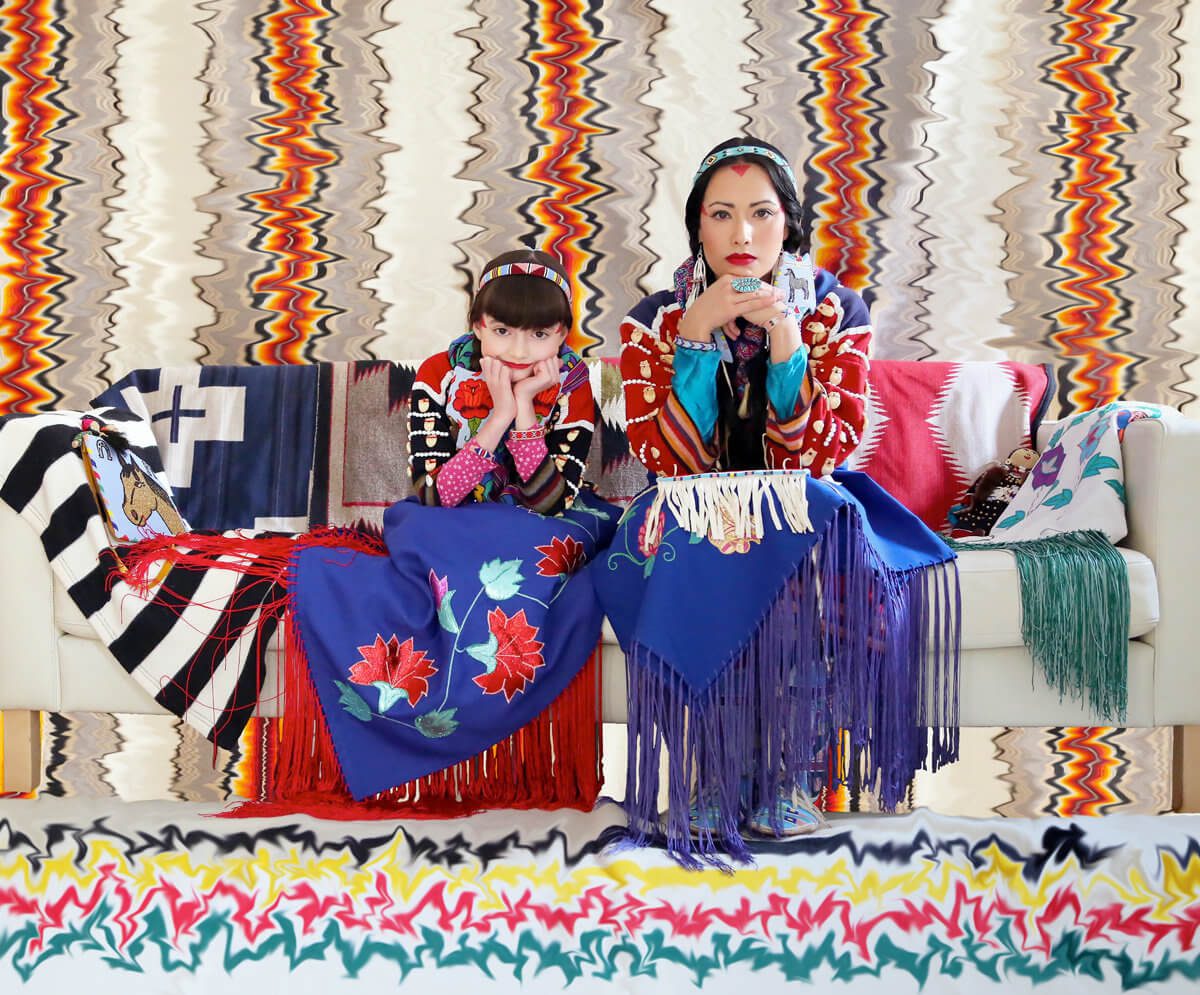Whilst trying to ‘overthrow the patriarchy,’ are we actually giving it undeserved airtime? In a world that tends to recognise negativity over positivity, perhaps it’s time to shift our perspectives and look back to the pre-colonial era at some traditional egalitarian societies. Maybe then, we might be able to discover where it all went wrong.
Contemporary Indigenous artist Wendy Red Star uses her own image to creatively approach the sensitive subjects of race, gender and indigeneity. Her playful, bright photographic utopias gently present feminism; they are easy for viewers to digest, without compromising artistic intent. Red Star is a descendant of the Crow tribe, which is one of the eight remaining matriarchal clans in which heritage descends through the maternal line. Here, women determine the lineage and bloodlines, proving the power of women outside of post-colonial gender structures.
Within groups like the Crow, women are not seen as ‘uniquely privileged,’ as the matrilineal principle is based on co-operation and support. The key to success is the allocation of practical and behavioural roles within the clan, dispersed evenly amongst members. Men and women’s responsibilities were equally significant for the success of the tribe. Unfortunately, the latter part of the 19th century saw an attack on these traditional gender roles. The US and Canadian governments implemented schemes to abolish tradition and create a society resembling the familiar Eurocentric concept of a ‘nuclear family’ and ‘civilised’ society. Unfortunately, this shift continues today. However, through the work of artists and activists such as Wendy Red Star, the memory of the Crow’s egalitarian society and cultural heritage prevails.
Red Star’s double portrait series Apsáalooke Feminist features herself and Beatrice, her eight-year-old daughter, posed and gazing steadily at the viewer.
In these images, Red Star’s daughter represents the enduring ancestry of the Crow tribe and her descendance through the female bloodline. Every pose Red Star makes, her daughter copies, but with an added air of child-like playful disobedience; where Red Star’s hands are neatly clasped, Beatrice adopts a mischievous smile and slumped shoulders. Within these playful scenes of colour and familial comfort, female strength is celebrated. Beatrice and her mother direct unwavering outward gazes at the viewer, challenging and defying the colonial notion of Indigenous peoples as passive objects. In this way, Red Star dictates the importance of maternal teaching, lineage and female power.
Alongside their portrayal of feminine power and identity, these images satirise colonial misinterpretations. Firstly, the artist’s use of vibrant red and blue along with patterns on the clothing are eye-catching, creating a theatrical aesthetic of the stereotyped ‘American Indian.’ Those of you familiar with the work of Aboriginal artist Tracey Moffatt, can see a clear similarity with the use of a theatrical diorama or backdrop to display colonial assumptions and misunderstandings.
Furthermore, Red Star and her daughter are set against psychedelic wallpaper, which engulfs them in a hypnotic, dream-like atmosphere, as if they are apparitions instead of living people. This is, in fact, their living room at home. By setting the photo series in her own home, Red Star enforces the continuing resilience of Native Americans alongside the paramount importance of family and bloodlines.
Contrasting with the theatrical backdrop, Red Star and her daughter are dressed in traditional elk-tooth dresses, shawls and beaded bags, highlighting the importance of female identity within the Crow society. Dresses carry great significance for women and girls within many Native American tribes, as they represent their connection to ancestry, community and family. Within the Crow community, men’s roles constituted more dangerous operations such as hunting, warfare, weapons manufacture and political matters. The elk-teeth, therefore, tell the story of a traditional custom in which a man would collect teeth over years of hunting and then save them for his mother or sister to sew onto the dress of his prospective wife.
On the other hand, women would take charge of physical labour, including agriculture, building tipis and foraging for wild plants, alongside household and child-rearing responsibilities. At a glance, it could be argued that the gender ratio here remains unequal. However, these women held a unique political position due to their place in a matriarchal society. They were allowed to divorce, unlike contemporary American women at the time, and to keep the land and house, as they were in ownership of them. Additionally, women were revered for their healing powers and craftwork, and were enlisted to care for sacred objects: an esteemed responsibility. Interestingly, art was something both men and women were involved in, whether it be embroidery, carvings, music or storytelling.
Through examining the structure of pre-colonial societies such as the Crow, we can begin to understand the importance of unique historical roots and traditions. Wendy Red Star uses her artistic flair alongside familial connections to heritage to create a powerful, engaging piece of work that gently provokes thought and understanding. Crow society no longer works entirely as it used to. However, all is certainly not lost thanks to the endurance of memory and representation of history by visual artists such as Wendy Red Star.
We acknowledge the Ngunnawal and Ngambri people, who are the Traditional Custodians of the land on which Woroni, Woroni Radio and Woroni TV are created, edited, published, printed and distributed. We pay our respects to Elders past and present. We acknowledge that the name Woroni was taken from the Wadi Wadi Nation without permission, and we are striving to do better for future reconciliation.
